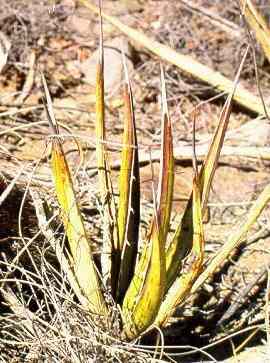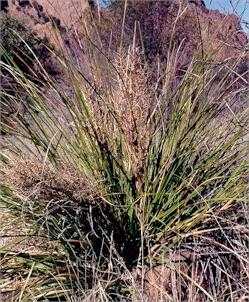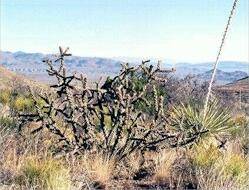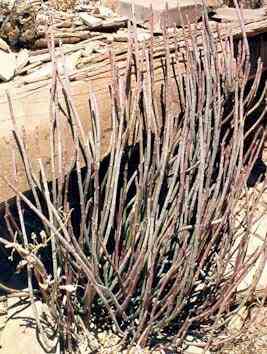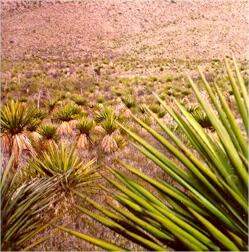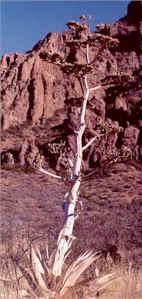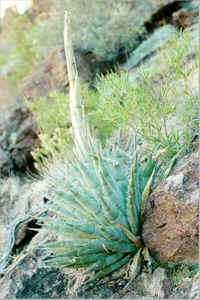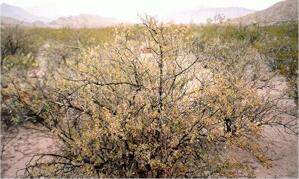CHIHUAHUAN DESERT PLANTS This page describes some of the more characteristic plants of the Chihuahuan Desert. The Chihuahuan Desert cacti are treated on a separate page. Lechuguilla (Agave lechuguilla) Lechuguilla is one of the smallest species of Agave - a genus that includes the very large and spectacular century plants. It is a very drought-tolerant plant, growing on rocky ledges or slopes. Each plant consists of only a few succulent leaves, up to about 30 cm height. The leaves are curved, with sharply pointed tips and spiny-toothed edges (seen on one of the centre leaves of the image above). One of the common names for this plant is shindagger. The plants flower by producing a long stalk, more than 2 metres high. Although lechuguilla is highly characteristic and common in the warmer parts of the Chihuahuan desert, it does not extend far into the northern extremes of the Chihuahuan Desert of the USA. [See lechuguilla for further information and images] Beargrass (Nolina species) Nolina is a genus of grass-like plants, commonly are called beargrass. But they are not grasses at all - they are related to the lily family and they produce large flowering spikes covered with many inconspicuous flowers. These spikes remain as dried brush-like clusters long after the seeds have been dispersed. The beargrasses typically occur as clumps on hillsides and in canyons above the deserts of Arizona and Texas. The non-succulent leaves have finely toothed margins, and they arise from a persistent undergraound rhizome. Sotol (Dasylirion species)
Sotol, or desert spoon, is a plant of the desert grassland zone, growing at elevations of about 1000-1800 metres in the Chihuahuan Desert of Mexico and southern states of the USA. It is placed in the same family as Nolina, related to the lily family. The individual plants are perennial and consist of a rosette of narrow leaves with small marginal teeth. Every few years they produce long flowering spikes, reaching 3 metres or more, covered with thousands of small green or white flowers. There are two species - D. wheeleri, and D. leiophyllum in western Texas. [See sotol for further information and images] Candelilla (Euphorbia antisyphilitica) Candelilla is a characteristic plant of the warmer parts of the Chihuahuan Desert in Mexico and southern Texas. Its greyish or purple-tinted photosynthetic stems have a thick wax coating. It grows on limestone ledges and slopes. A related but distinctly more robust plant, also called candelilla, grows in parts of the Mexican Sonoran desert. [See candelilla for further information and images] Yucca (Spanish dagger) Several species of Yucca are common in the Chihuahuan Desert and can be the dominant component of the vegetation on upland slopes. These plants typically have rosettes of long, stiff, pointed leaves - one of their common names is Spanish daggers. They are drought-tolerant plants, with thick leaves and they are quite frost-tolerant. As they age, these plants develop trunks covered with the old leaf bases, and often with a "skirt" of dead leaves that hang down. Every few years they produce a short spike covered with cream-white, bell-shaped flowers. Pollination of the flowers is achieved by yucca moths, which have an intriguing symbiosis with the host plant. The two plants illustrated here are the Torrey yucca (Yucca torreyi) and the banana yucca (Yucca baccata). Torrey yucca has tough, lance-shaped, evergreen leaves, and it sometimes grows in extensive stands in regions of the Chihuahuan Desert. [See Yuccas for further information and images] Agave species (century plants)
Agave species characteristically are large, slow-growing plants with a basal rosette of thick, succulent leaves. They are drought-tolerant and grow at a wide range of altitudes, from lowland desert sites (e.g. the coastal agave) to mountain zones, and from as far north as Utah down to the northern parts of South America. With the exception of lechuguilla, the Agave species of the Chihuahuan Desert typically grow on rocky ledges or steep outcrops in the mountain canyons. They accumulate nutrient reserves for 20-30 years or more and then flower once by producing a large candelabra-like spike. After this, the plant dies, but by this stage many species would have produced offsets ("suckers") from the parent plant, and these offsets then replace the dead parent. [See Agaves for further information and images] Tarbush (Flourensia cernua) Tarbush is a small shrub, usually 1-1.5 metres tall, with dark bark and sticky, resinous, aromatic leaves. It is highly characteristic of the Chihuahuan desert, where it sometimes forms pure stands or is co-dominant with creosote bush on the calcareous flat plains or gentle slopes. The leaves appear after summer rains and turn brown after frosts later in the season, but the withered leaves often persist on the plants until the next growing season. This plant is a member of the daisy family (Compositae). It produces yellow flowers in nodding heads, but they are not conspicuous. Go to Chihuahuan
Desert Cacti? |
